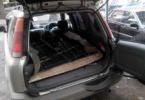Unfortunately, not every person has the opportunity to purchase an ATV in the store. All more or less interesting models are now quite expensive, and buying a supported ATV is always a certain risk. In this regard, many motorcycle enthusiasts advise to make a four-wheeled all-terrain vehicle with their own hands, using an engine and spare parts from some old Soviet motorcycle. Earlier, we have already told you about how to make an ATV from a Ural motorcycle. In today's article, we will talk about other donors that you can use if you decide to assemble an ATV with your own hands.
Why is it worth assembling an ATV with your own hands?
Assembling a four-wheeled all-terrain vehicle with your own hands definitely helps to solve several problems. The first reason people decide to make a homemade ATV is of course a small budget. If you analyze the market prices for ATVs, then you can understand that such vehicles can be considered almost a luxury. Prices for the simplest and low-power models start at 150 thousand rubles, for example, the Yamaha Blaster YFS200. In principle, such a single "quadric" will be enough, but the power will always be in short supply.
But models of ATVs with engines with a volume of 500-800 cm 3 will cost much more, about 500 thousand rubles. You can also consider Chinese models, such as the Russian manufacturer Stels, but they will have to be well monitored. New all-terrain vehicles of this brand will cost about 300-400 thousand rubles, but the engines are already much more interesting - 45-70 hp.
Nuances in the operation of a homemade "quadric"
If you definitely decided to make an ATV with your own hands, then you should know about the intricacies of its operation. Basically, if you need an all-terrain vehicle to ride in impassable places, where there have never been patrol cars, then there is probably nothing to worry about. You will have to face problems if you plan to drive even in small settlements, which are sometimes visited by patrol cars. Having caught you without documents for this vehicle, then with a probability of 99% they will take it away from you. The whole difficulty lies in registering a homemade ATV, because the traffic police will most likely refuse you. In an amicable way, you can register a homemade product, but it is extremely difficult to do this. Therefore, assembling a homemade ATV only makes sense if you operate it in some wilderness.
Decide on the choice
So how to make a do-it-yourself ATV? When creating a homemade ATV, we need to decide on a donor, that is, a motorcycle that will form the basis of our project. Old Soviet motorcycles are perfect for a four-wheeled all-terrain vehicle. From them we can borrow an engine with a gearbox, a frame, a steering wheel and, if desired, such details as a tank, a seat and other elements. Since we already had an article about a homemade ATV from the Ural motorcycle, in this review we will talk about how to make an ATV based on the IZH motorcycle.
For our purpose, almost all motorcycle models from the Izhevsk plant are suitable for us. The only thing that is important to understand is the engine power. Still, the end result will be a fairly heavy structure, so the best solution would be to use the latest models - IZH Jupiter 5 or IZH Planet 5. It makes no sense to consider more interesting models, like IZH Planet Sport, because it is quite difficult to find them, and if possible , it is better to restore them, because the motorcycle is quite rare and interesting. Let's move on to the main thing, how to make an ATV and what is needed for this.

Rear suspension
Once you have decided on a donor, in our case it is IZH Jupiter 5, you need to completely disassemble the motorcycle. After disassembling, we need a frame on which everything was held, including the engine. It is quite logical that in order to increase the reliability of the structure, the frame must be strengthened in several places.
Now it is necessary to weld the rear axle so that instead of a wheel, a bearing block with a chain drive can stand on the axle. An example, you can see in the photo. As a suspension, you can use ordinary shock absorbers from a motorcycle, and parts from an old Zhiguli car are suitable for the rear axle. You can go a more complicated way and install a monoshock, but then again you will have to look for spare parts from the car, for example, from the same Zhiguli or Oka.
Front suspension
Once the rear suspension is complete and in place, you can move on to the front of the bike, which is a little more complicated. In the case when we were dealing with the rear suspension, we had the opportunity to choose how much the shock absorber will be installed. When creating the front suspension, we only have one option - to use two shock absorbers.
Oka's car is perfect for the role of a donor for the front of the ATV. From it we need shock absorbers, swivel assemblies and a steering linkage. However, be prepared for the fact that the parts will still have to be changed - to weld on, saw off, saw off something. Also a good and simpler option would be to install a monoblock with fixed wheel surfaces. Then you don't have to look for a steering linkage, couplings, hinges and other spare parts.
A monoblock is a really simple option, because it literally takes an hour to install. The only drawback of this design of the front suspension is the heavier mechanism. The steering wheel will be slightly more difficult to turn than with a suspension with shock absorbers.

Engine
Many wondering how to make an ATV with their own hands, understand that it is worth starting with the engine. Indeed, the main detail in the future ATV is the engine. The final result, and the whole structure in general, depends on how powerful it will be. Of course, you can leave the engine from the donor's motorcycle, but in the end, the "quad" will not be as powerful. If you are a little more serious about creating an all-terrain vehicle, then installing a more powerful engine would be an excellent solution. We hope we have answered your question on how to make an ATV yourself.
Today we will look at how to assemble a real ATV using car parts from VAZ, Oka and various materials that are in everyone's garage.
This all-terrain vehicle was manufactured for purely recreational use. Based on this, in the process of its creation, the author took into account factory ATVs and his own car. The result is an ATV with a number of distinctive features that improved its cross-country ability and significantly distinguished it in comparison with industrial ATVs.
To create an all-terrain vehicle from the materials were taken:
fragment of a water pipe, diameter 32 mm;
pipe 27 mm;
internal combustion engine from the car Oka 11113;
gearbox of the same car;
front and rear gearbox from VAZ;
hubs, grenades from VAZ 2109;
fiberglass.
List of tools used:
welding machine;
drill;
Bulgarian;
spanners;
hammer;
knife;
calipers;
roulette.
Step-by-step description - DIY ATV assembly
First of all, the frame was made - from a water pipe with a diameter of 32 mm. The suspension of the ATV is made on its own - for this you need to take A-shaped levers made of a pipe with a diameter of 27 mm. The engine and gearbox from the Oka car are installed, the differential is welded.
The gear ratio is 43 to 11, this is about the front and rear gearbox, they were converted for internal grenades from the VAZ 2109.
Disc brakes with hubs are also from the VAZ 2109, and 15 radius wheels are installed through spacers.
Next, the craftsman installed and adjusted the clutches of the ATV-ATV:

At first, it was decided to place the clutch on the handlebars - like a motorcycle. But in the end it was placed under the leg on the left side. And although this has become an unusual option, as for ATVs, it is nevertheless convenient for the author. During the ride, the gears are switched easily and clearly. At the same time, the all-terrain vehicle can get under way from any gear, with a passenger on board as well - the engine has sufficient power. Gears do not have to be changed often. When driving on the road, usually the third or fourth gear is engaged, on the off-road - the first or second as low gear.

The author built a transfer case of his own design, which made it possible to disable the front axle. Here we can see a photo showing the entire front axle deactivation mechanism, the main parts of the structure:

Rear suspension of the ATV. We prepare the frame before gluing it with fiberglass, after which we impregnate it with epoxy resin.


We adjust and grind the fiberglass on the body, the next step is painting.

In the all-terrain vehicle, we hid the radiator under plastic in front of the dashboard. Although there is a very small hole there, it is still quite enough to cool the ATV properly. It should be borne in mind that if you drive in heavy mud, the hole may become clogged and cooling will be difficult. But nevertheless, as practice shows, when driving on serious off-road, the fan copes well with such tasks. It turns on only under very serious loads, which happens very rarely.

The fact is that the all-terrain vehicle that we have assembled differs in a rather low weight, and in this case the engine from the Oka copes very well with the tasks of an ATV.
Here is a photo showing the location of the radiator:

4x4 ATV test video
ATVs are becoming more and more popular due to their lightness, maneuverability, high cross-country ability and at the same time compactness. Indeed, an ATV is something between an all-terrain vehicle and a motorcycle. It also has a high cross-country ability like an all-terrain vehicle, it can be used for cross-country, off-road, mountain or forest travel, but at the same time, unlike a motorcycle, the ATV is more stable.
Homemade four-wheel drive ATVs - our answer to expensive equipment
An ATV is not cheap, and not everyone can afford it. But to design a homemade 4x4 ATV is quite simple, you just need old parts from a car or motorcycle, a little imagination and a great desire. By the way, it is all-wheel drive ATVs that are more popular because of their cross-country ability and all-terrain vehicle.
Where to start for DIY ATV assembly?
There are many forums or rework sites on the Internet that walk you through the steps and explain how to build, so it's not that hard to find information on the subject. It is much more difficult to disassemble blueprints, especially if you do not have the necessary skills. But without drawings, it is impossible to build a home-made four-wheel drive ATV, in principle, like any other technique. So if you have a dream to cut through the terrain on a self-assembled ATV, you will have to deal with the drawings. Well, if you have a technical education and you know exactly how the units of machine assemblies work, you can build your own drawing to make a unique technique.
ATV transmission diagram:
Oka, ZAZ, Ural or Minsk are more often taken as the basis for ATVs, but those parts that you have lying around like rubbish in the garage are also suitable. Some parts still have to be bought, but it is still much more profitable to build than to purchase a ready-made one. And in the event of a breakdown, find spare parts for your national team from "VAZ", "Ural", etc. ATV will be much easier than expensive imported equipment.
An ATV is an all-wheel drive car and a motorcycle, an enduro-cross bike, in one bottle. The features of this type of transport are compactness, tires with deep treads for better off-road grip, 1-2 seats and no roof over your head. This type of transport first appeared in Japan in the 1970s and won the hearts of many off-road romantics. Such transport will interest hunters, fishermen, and those who like to conquer impassable terrain. Many of us dream of such a toy for adults. We will tell you how you can make your dreams come true with your own hands.
Choosing an engine for an ATV
The most important part for your all-terrain vehicle will be the powertrain. Most often, motorcycle engines are used (they are economical and small in size). For example, an engine from the "Ural" or "Minsk", IL "Planet" or IL "Jupiter" will do. You can adapt the engine from "VAZ" or "Oka" to your ATV. To avoid overheating the engine in hot weather, you need to choose a model with an air-cooled system. The most popular option is to carry over vehicle forced cooling.
Retrofitting an existing frame or blueprints from scratch

Before any undertaking, an action plan and a design drawing or a finished frame are needed. If you yourself are friends with mathematical calculations, then you can calculate everything yourself. If you do not make a drawing, then you can contact a specialist or look for a design scheme that suits you on the Internet.
The easiest way is to take a ready-made motorcycle frame as a basis and weld all the missing parts onto it. The order of your actions is as follows: dismantle the old motorcycle. We leave only the frame. Cut off the rear part of the frame with the pendulum fork mount. We extend the frame with pipes and weld on the bridge (use jibs and kerchiefs). Pre-flip the automobile axle so that the quadric can go forward, not backward (because on the "Ural" gearbox at the output, the direction of rotation is reversed).
Remember that the axle gearbox must be easy to remove in case of replacement. We are looking for spare parts from a passenger car: 2 front hubs, a rear axle (so that the disks match the fasteners with the hubs), a propeller shaft, front suspension arms, tie rods, a ¾ inch round water pipe.
 If there is no donor motorcycle, then the frame is best made of durable alloys: pipes, profiles, spot welded together. For the supporting parts of the frame, you can buy water pipes (VGP 25 × 3.2). You must have equipment that allows you to bend the pipes in the right place. For the body, we cook a frame from a 70 × 40 pipe. The length should not be shorter than the spring, and the width should correspond to the size of the bridge. When using jibs, do not forget about the torsional rigidity of the structure.
If there is no donor motorcycle, then the frame is best made of durable alloys: pipes, profiles, spot welded together. For the supporting parts of the frame, you can buy water pipes (VGP 25 × 3.2). You must have equipment that allows you to bend the pipes in the right place. For the body, we cook a frame from a 70 × 40 pipe. The length should not be shorter than the spring, and the width should correspond to the size of the bridge. When using jibs, do not forget about the torsional rigidity of the structure.
We connect the cardan with the box with the "Ural" rubber coupling. Through the crosspiece of the hinge with a flange, we connect the cardan to the bridge. If the donor was IL, then the drive is carried out by the native chain.
If your quad has springs on shock absorbers, leave the rear swingarm along with the silent blocks. Weld the bridge to the fork (remember to reinforce the seams with wide kerchiefs to prevent sweat vomiting). Instead of a cardan shaft, use the axle shaft from the Oka or VAZ. We leave the springs with shock absorbers as they are, do not touch them. When the frame structure is ready, we proceed to fasten the engine to the bottom of the frame using bolts. The engine can be located both in the back and in the front (no difference). The muffler can be home-made, two-piece.
 Now we mount the transmission on the rear wheels so that no backlash is formed. The drive comes with an old motorcycle engine. Wheels on the quad can be supplied from "Niva". If you need a trunk, you can weld it from thin-walled steel pipes. The bumper can be replaced by "kenguryatniki".
Now we mount the transmission on the rear wheels so that no backlash is formed. The drive comes with an old motorcycle engine. Wheels on the quad can be supplied from "Niva". If you need a trunk, you can weld it from thin-walled steel pipes. The bumper can be replaced by "kenguryatniki".
Control type
To keep your ATV safe in operation, you will have to take care of the type of control. Your ATV can have 2 types of controls: a steering wheel (we take the basis from the car - steering rods) and a steering wheel from a used motorcycle (lever and shaft). The steering shaft can be made from a tube with a diameter of 20 mm and a wall thickness of 2.8 mm. Place a travel stop at the lower end. Thus, at the bottom, the shaft rests on a thrust bearing, and in the middle it turns in a split nylon bracket-sleeve.
Suspension: front and rear
 Your ATV can be fitted with either rear or front suspension. For the rear suspension, the following solution is suitable:
Your ATV can be fitted with either rear or front suspension. For the rear suspension, the following solution is suitable:
1. To make the design lightweight and simple, a gear-cardan system is needed. There is no differential in this case.
2. The structure will turn out to be very heavy if you use a road bridge (it has to be shortened). In this case, there is a differential that will be needed when driving.
For the front suspension, you can take as a basis the suspension from the "Ural" or IZH. Installing the front suspension is more time efficient - it is faster than four-wheel drive, where you will need the help of professional turners, electricians, welders (some revision will be needed).
To attach the swing arms, the motorcycle frame is lengthened at the front. It must be installed so that the turning wheels do not touch the engine cylinders. Therefore, on the frame of the "Ural" the wheels are put further forward. To increase the geometric cross-country ability, the suspension arms should be as long as possible.(you need to make these yourself). To the steering column (made of the "Ural" cardan) at the bottom we weld two steering bipods next to it: on the right and left wheel. The hubs are attached by means of native ball.
 When installing the A-pillar, be aware of the tilt of the rack. This will prevent the steering wheel from knocking out on bumps and will help bring the steering wheel back into place when cornering. If there is no tilt, you can fly by inertia, returning the steering wheel to the opposite position on off-road conditions will be very problematic.
When installing the A-pillar, be aware of the tilt of the rack. This will prevent the steering wheel from knocking out on bumps and will help bring the steering wheel back into place when cornering. If there is no tilt, you can fly by inertia, returning the steering wheel to the opposite position on off-road conditions will be very problematic.
All-wheel drive ATV
For an all-wheel drive ATV, you will need:
- drive from a mechanical transmission with a power take-off gearbox to the front wheels;
Wheel differentials;
Front-wheel steering (like a car);
Independent suspension (you can also multi-link) or dependent suspension.
If it is not possible to assemble everything yourself, take the suspension from the "Oka" or front-wheel drive VAZs. We cook the frame from scratch for the Oka engine. In the front suspension, we leave room for the front wheel drive reducer. You can do it yourself: we cut off the "stockings" of the bridge and remove the suitable axle shafts from the VAZ from the differential. We turn the engine backwards. Now the axle shafts have become cardan shafts that drive the front and rear axles.



